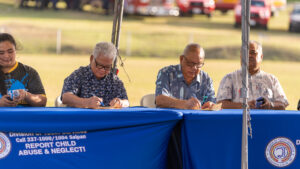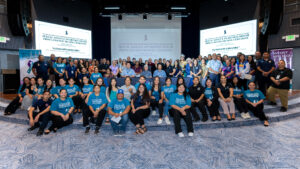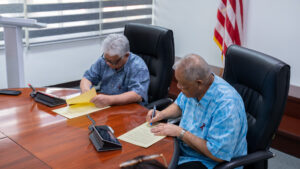Governor Ralph DLG. Torres on Monday announced the safe completion of the interim removal action (IRA) of hazardous munitions at the CNMI Substance Abuse, Addiction, and Rehabilitation (SAAR) Program’s HOPE Recovery Center in Marpi, made possible through the coordinated efforts of the United States Army Corps of Engineers (USACE), HydroGeoLogic, the HOPE Recovery Center Staff, and CNMI government departments and agencies.
In 2017, the USACE conducted surface assessments throughout the HOPE compound, and it was apparent that anomalies were present in plain sight. After joining in discussions regarding the ordnance present at the HOPE Compound, and learning that the larger ordnance removal project would be completed in 2035, SAAR, through the assistance of local departments and agencies, requested for the prioritization of the HOPE Compound ordnance removal through a Time Critical Removal Action (TCRA) in February 2020. This project, through the TCRA, officially started in October 2021, and then completed in February 2022.
Governor Torres is grateful for this collaboration, “I want to thank our local government departments and agencies involved in this project, and especially the U.S. Army Corps of Engineers, who have guided this project to its completion. Thank you for your partnership in addressing the issue of munitions that were left here on this land decades ago. The CNMI is thankful for the timely response, prioritization, and completion of this project, so that the critical functions and services of our HOPE Recovery Center can safely continue for our community,” said Governor Torres.
Lieutenant Colonel Eric Marshall, Commander of the Honolulu District U.S. Army Corps of Engineers, stated that upon the 14 acres of land on the HOPE Compound, HydroGeoLogic found almost 2,000 munitions and explosives of concern, which posed a threat to the residents and staff of the HOPE Recovery Center. Additionally, almost 76,000 pounds of debris of any type were able to be remediated and moved to recycling, following the first ever TCRA for the CNMI. He conveyed the importance of the HOPE Recovery Center being able to move into its next stages, through Governor Torres’ vision and the work of SAAR Special Assistant Yvette R. Sablan and the HOPE Recovery Center staff.
Substance Abuse, Addiction, and Rehabilitation (SAAR) Program Special Assistant Yvette R. Sablan expressed her appreciation for Commander Marshall and the U.S. Army Corps of Engineers, “I deeply appreciate that you recognized and shared with me that, while this land held a history of a battle, it is nice to see that it is now being used to bring healing to its people. This whole project signifies the work that we do up here at the HOPE Recovery Center. We, too, cannot do this work alone. And we, too, need our partners.”
“What an honor for this administration, under the leadership of our Honorable Governor Ralph DLG. Torres, the HOPE Recovery team, and for everyone here to have witnessed and be a part of a history that will tell a story of healing: that of our land and of its people – and that of a relationship with our military partners that brought us healing,” said Special Assistant Sablan.
###








